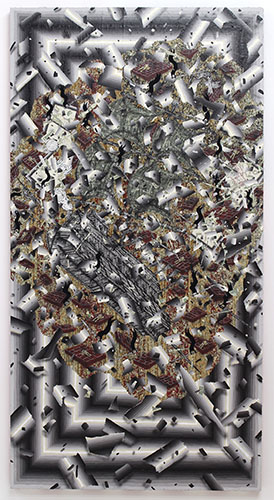 |
 |
The show opens with a series of paintings on wood panels. They appear as jigsaw puzzles, their sliced-open edges revealing Day-Glo colors. They’re suitably toxic-looking but only a preface to the main event: Blown to Bits (Exploding Wall), a 20-foot long painting that is the exhibition’s title piece. It shows horses invading an exploding edifice surveilled by floating eyeballs. They’re the same eye-of-God symbols that appear on the dollar bill; only here they’re cast as emblems of the security state we’ve become. Frozen in space, these elements combine in a seamless mix of comic, graphic, muralist, minimalist and Pop styles, making the painting feel chaotic. The effect is multiplied by Schoultz’s “framing” of the piece in concentrically shaped rectangles. These he paints on the wall outside the piece in the manner of Frank Stella, creating the illusion of a screen or a proscenium. This effect is further enhanced by the painting’s position between two of the gallery’s concrete support pillars — and by the artist’s stationing of two wood benches in the foreground, spray painted in Play Dough colors. The installation achieves cinematic impact at a scale perfectly suited to the space.
.jpg) |
surface. Rendered in the manner of a woodcut, and with sails crosshatched on swatches of currency, it speaks powerfully of human bondage and of the moral quagmire of raw Capitalism. (Slavery, as of late, has been a popular subject of scholarly inquiry; I counted three such tomes reviewed in last Sunday's New York Times Book Review, not to at least six others that have appeared over the past few months.)
Dave, your review is both spectacular and svelt! This is an important show for us all and you’ve captured it with elegance. Thanks, Mary
Saw the show..very exciting visually…love the broken paintings and drawing…